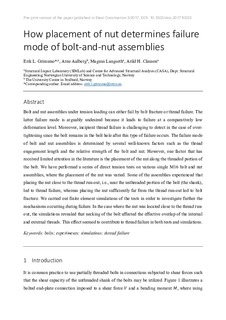| dc.contributor.author | Grimsmo, Erik Løhre | |
| dc.contributor.author | Aalberg, Arne | |
| dc.contributor.author | Langseth, Magnus | |
| dc.contributor.author | Clausen, Arild Holm | |
| dc.date.accessioned | 2017-12-19T12:18:16Z | |
| dc.date.available | 2017-12-19T12:18:16Z | |
| dc.date.created | 2017-09-20T20:28:21Z | |
| dc.date.issued | 2017 | |
| dc.identifier.issn | 1867-0539 | |
| dc.identifier.uri | http://hdl.handle.net/11250/2472876 | |
| dc.description.abstract | Bolt-and-nut assemblies under tension loading can either fail by bolt fracture or thread failure. The latter failure mode is arguably undesirable because it leads to failure at a comparatively low deformation level. Moreover, incipient thread failure is challenging to detect in the case of over-tightening since the bolt remains in the bolt hole after this type of failure occurs. The failure mode of bolt-and-nut assemblies is determined by several well-known factors such as the thread engagement length and the relative strength of bolt and nut. However, one factor that has received limited attention in the literature is the placement of the nut along the threaded portion of the bolt. We have performed a series of direct tension tests on various single M16 bolt-and-nut assemblies where the placement of the nut was varied. Some of the assemblies experienced that placing the nut close to the thread run-out, i.e. near the unthreaded portion of the bolt (the shank), led to thread failure, whereas placing the nut sufficiently far from the thread run-out led to bolt fracture. We carried out finite element simulations of the tests in order to investigate further the mechanisms occurring during failure. In the case where the nut was located close to the thread run-out, the simulations revealed that necking of the bolt affected the effective overlap of the internal and external threads. This effect seemed to contribute to thread failure in both tests and simulations. | nb_NO |
| dc.language.iso | eng | nb_NO |
| dc.publisher | Ernst und Sohn | nb_NO |
| dc.title | How placement of nut determines failure mode of bolt-and-nut assemblies | nb_NO |
| dc.type | Journal article | nb_NO |
| dc.type | Peer reviewed | nb_NO |
| dc.description.version | acceptedVersion | nb_NO |
| dc.source.journal | Steel Construction | nb_NO |
| dc.identifier.doi | 10.1002/stco.201710025 | |
| dc.identifier.cristin | 1495996 | |
| dc.relation.project | Norges forskningsråd: 237885 | nb_NO |
| dc.description.localcode | This is the peer reviewed version of the following article: [How placement of nut determines failure mode of bolt-and-nut assemblies], which has been published in final form at http://onlinelibrary.wiley.com/doi/10.1002/stco.201710025/abstract. This article may be used for non-commercial purposes in accordance with Wiley Terms and Conditions for Self-Archiving. Locked until 10.8.2018 due to copyright restrictions. | nb_NO |
| cristin.unitcode | 194,64,45,0 | |
| cristin.unitname | Institutt for konstruksjonsteknikk | |
| cristin.ispublished | true | |
| cristin.fulltext | postprint | |
